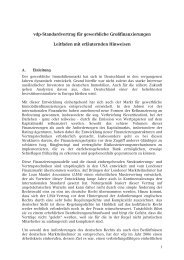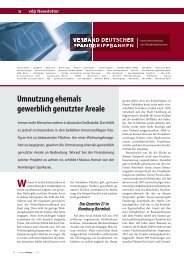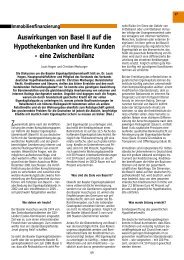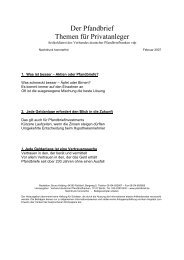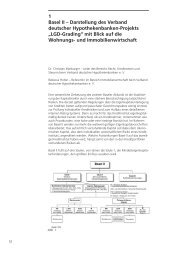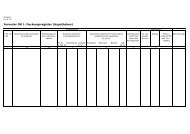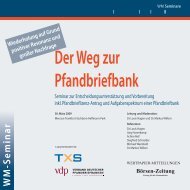The Pfandbrief 2011 | 2012
The Pfandbrief 2011 | 2012
The Pfandbrief 2011 | 2012
Create successful ePaper yourself
Turn your PDF publications into a flip-book with our unique Google optimized e-Paper software.
account of its macro strategy, has to underweight peripheral European countries, for instance,<br />
orientation to the iBoxx EUR Covered Index leads by definition to a tracking error. In order to<br />
account for this, correct benchmarking is accomplished through individually calculated indices<br />
– which may be composed of sub-indices of an existing index family.<br />
In the following, we will present an overview of select covered bond indices, their composition,<br />
and the most important index rules.<br />
Citigroup Covered Bond Index<br />
Citigroup’s definition of covered bonds covers all <strong>Pfandbrief</strong>e and covered bonds issued principally<br />
in the Euro region. In 1997, Citigroup introduced the Jumbo <strong>Pfandbrief</strong> Index. It is a<br />
component of the Euro Broad Investment-Grade (EuroBIG) Index and a part of the Collateralized<br />
sub-category. Citigroup sets the Jumbo criteria for the index, such as minimum volume<br />
of EUR 1 billion, fixed-income coupon, and at least five market makers.<br />
Barclays Covered Bond Indizes<br />
Covered bonds can be found in a number of Barclays indices. For instance, they are contained,<br />
in particular, in the Global Aggregate Bond Index, in which they represented 4.1% of the total<br />
volume as of October 2009, in the Pan-European Aggregate Bond Index, at 10.6%, in the<br />
Sterling Aggregate Bond Index, at 0.4%, in the Asian Pacific Aggregate Bond Index, and in<br />
the aggregated indices U.S. Universal Bond Indices, at 0.2%, and the Pan-European Universal<br />
Index, at 10.4%. <strong>The</strong> fundamental selection criteria for including bonds in the respective<br />
indices are normally an outstanding minimum volume of EUR 300 million (or GBP 200 million<br />
or USD 300 million), an investment-grade rating, a minimum time to maturity of one year, a<br />
fixed-income coupon, and public placement of the bond.<br />
47<br />
PEX<br />
<strong>The</strong> <strong>Pfandbrief</strong> index PEX, which is listed on the Deutsche Börse, consists of 30 characteristic<br />
synthetic <strong>Pfandbrief</strong> issues having maturities of one to ten years in one-year increments and<br />
with each having coupons of 6%, 7.5%, and 9%. <strong>The</strong> PEX is calculated using the yields from<br />
transactions entered into by the <strong>Pfandbrief</strong> issuers or for which they have set rates. In addition,<br />
there are sub-indices for maturities buckets of one to ten years. Each of the characteristic<br />
<strong>Pfandbrief</strong>e is weighted with its market share. <strong>The</strong> weighting matrix was ascertained from the<br />
market structures of three interest cycles and is reviewed annually. <strong>The</strong> overall PEX index is<br />
calculated in three steps: (i) calculation of zero-coupon yields (spot rates) from the reported<br />
yield data, (ii) valuation of 30 synthetic <strong>Pfandbrief</strong>e with a remaining time to maturity of one<br />
to ten years and of the three coupon classes, and (iii) weighting of these 30 bond prices and<br />
aggregation into the PEX price index. Using the PEX, the PEXP performance index can be<br />
determined, which reflects the value trend of a hypothetical <strong>Pfandbrief</strong> portfolio with no with-




